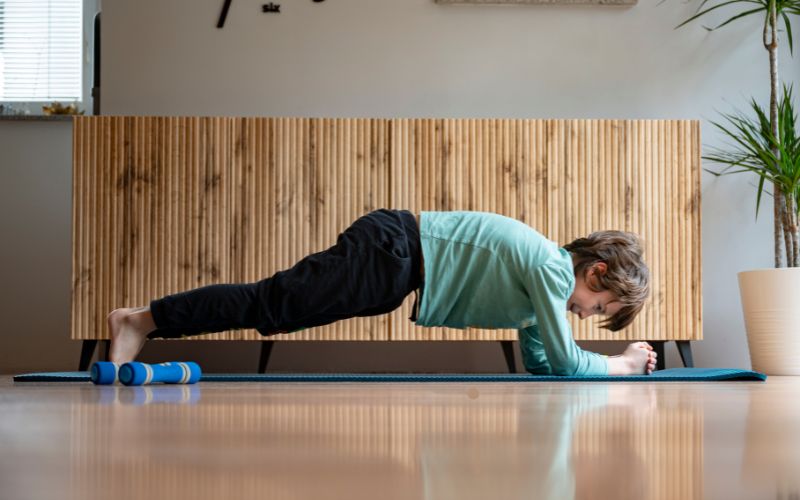Strong forearms enable you to grip, lift, and move more effectively every day. These muscles connect your hands to your upper arms. When your forearms get stronger, your whole body benefits. This guide shows you how to train your forearms at home. You can use easy exercises and follow a simple plan to build real strength. You do not need a big gym or fancy equipment. Ativafit gear makes training easy and safe.
You can choose your level and improve from there. Continue reading, follow each tip, and begin your journey to strong, functional forearms that look great. Build stronger forearms at home with Ativafit Adjustable dumbbells.

Why does Forearm Strength Matter?
Forearms power every grip, lift, and carry. Without strong forearms, even basic gym exercises feel more challenging. Forearm muscles help stabilize your wrists and elbows. They protect joints and improve coordination. Athletes, builders, musicians, and lifters need strong wrists and fingers.
Good forearm strength improves balance in upper-body training. It prevents wrist injury, boosts bar control in lifts, and supports better body alignment. Training in this area also improves hand endurance for longer workouts. Whether you carry groceries, swing a bat, or row a boat, forearm power helps.
Understanding Forearm Anatomy
The forearm extends from your elbow to your hand and is packed with 20 muscles that control wrist, elbow, and finger movements. The muscles are divided into flexors and extensors:
-
Flexors, located on the underside of the forearm, assist in bending the fingers and wrist.
-
Extensors, on the top side, extend the fingers and wrist.
One of the major players in forearm development is the brachioradialis, a strong muscle that does not cross the wrist joint. It's engaged in elbow flexion rather than in wrist actions. To properly develop this muscle, emphasize exercises that involve bending of the elbow, such as reverse curls and Zottman curls.
Advantages of the Ativafit Adjustable Dumbbell for Forearm Workout

The Ativafit 66 lb adjustable dumbbell (DT1166) is a useful addition to a home or gym routine with important advantages:
1. Wide weight range (11–66 lb)
With 12 adjustable settings in 5 lb increments, the dumbbell accommodates everything from light warm-ups to maximum lift. This enables you to gradually overload your forearm muscles, resulting in continuous strength gains.
2. Quick on-the-fly adjustment
The Dial Tech system lets you change weights in seconds—press the safety tab, turn to your chosen weight, and lift. It's all smooth and quiet, allowing you to maintain your workout intensity uninterrupted.
3. Space-saving, compact
These adjustable dumbbells take the place of up to 12 sets of fixed weights. Perfect for home gyms or small areas—no need for heavy racks.
4. Durable, heavy-duty construction
The DT1166 features laser-cut steel plates and anti-slip handles, reinforced with extra strength, and is built for real results through high-volume reps and heavy-duty training.
What are the Best Forearm Exercises Using Plates and Dumbbells?

To maximize forearm size and strength, you don’t need endless isolation exercises. Instead, focus on these:
1. Palm Down Wrist Curls
This exercise targets the wrist flexors, which rest on the back of your forearm. It not only develops size but also tightens the wrist joint and grip.
How to Do:
-
Sit or kneel in front of a flat bench or an Ativafit Multi-Purpose Home Workout Bench.
-
Place your forearms on the bench with your palms facing up and hold the Ativafit adjustable dumbbells.
-
Slowly curl the wrists upwards, hold at the top, and then return to the initial position.
-
For 15–20 reps with a tempo that is slow to create maximum time under tension.
Tip: Keep your forearms static—only the wrist should move to isolate the target muscles.
2. Palm Up Wrist Curls
To balance your forearm development, flip your grip and perform the palm-up variation, which targets the wrist extensors on the top side of your forearm.
How to Perform:
-
With your palms down and forearms resting on a bench, curl the adjustable dumbbells up towards yourself using your wrists while keeping your palms facing down.
-
Pause at the top, then reverse direction.
-
Similar to the palm-down curls, shoot for 15–20 reps.
Use slow and deliberate movements throughout the set to engage all the small stabilizer muscles.
3. Reverse Grip Curl
This exercise targets the brachioradialis, which helps develop the thickness in the upper forearm. It's a game-changer workout for forearm mass.
How to Do It:
-
Hold a barbell with an overhand (pronated) grip.
-
With your elbows tight and arms by your sides, curl the bar up to shoulder level, emphasizing flexion of the elbows.
-
Slowly return it to the starting position.
-
Do 10–12 reps.
For even more brachioradialis activation, try partial reps in the top third of the movement, where this muscle is most active.
4. Zottman Curl
This curl offers the best of both worlds: biceps on the way up and forearms on the way down.
How to Perform:
-
Start with Ativafit dumbbells at your sides in a supinated (palms-up) grip.
-
Curl the dumbbells up, rotating wrists to a pronated (palms-down) grip at the top.
-
Slowly lower the dumbbells to the new position.
-
Rotate back and repeat.
Emphasize controlling the eccentric (lowering) phase to test the forearm muscles.
5. Farmer's Carry
Grip strength is a crucial aspect of overall forearm strength, and few exercises are as effective at building it as the farmer's carry. It also teaches your traps, core, and posture.
How to Do:
-
Grasp a heavy set of dumbbells or Ativafit Adjustable kettlebells, stand up straight, and walk 30–60 seconds.
-
Keep your arms extended and have a firm grip.
Try using a hook grip (thumb locked under fingers) for added security and challenge.
6. Plate Pinch
This underutilized movement is remarkably effective for targeting your pinch grip, a crucial component of grip strength that standard exercises often overlook.
How to Perform:
-
Pick up two weight plates by pinching them together between your fingers and thumbs.
-
Stand tall and hold them for as long as possible, ideally up to 60 seconds.
Pro Tip: Start with light plates (5–10 lbs) and gradually increase the weight. Don't wrap your fingers around the edge of the plate—pinch only!
Weekly Forearm Workout Plan

Here's a well-rounded weekly workout plan that can fit into most upper-body strength programs. Perform forearm exercises 2–3 times per week, preferably after the main lifts or on dedicated arm days.
|
Day |
Exercises |
Sets |
Reps/Time |
|
Monday |
Palm Down Wrist Curl |
3 |
15–20 reps |
|
Reverse Grip Curl |
3 |
10–12 reps |
|
|
Plate Pinch |
3 |
30–60 seconds |
|
|
Wednesday |
Farmer’s Carry |
3 |
40–60 seconds |
|
Palm Up Wrist Curl |
3 |
15–20 reps |
|
|
Zottman Curl |
3 |
10–12 reps |
|
|
Friday |
Reverse Grip Curl (partial ROM top) |
3 |
10–12 reps |
|
Farmer’s Carry (heavy) |
3 |
40–60 seconds |
|
|
Plate Pinch |
3 |
30–60 seconds |
Final Thoughts
You don't have to spend an hour on a workout to train your forearms. A careful choice of exercises that engage wrist movement, elbow flexion, and grip strength will help you grow in size and function over time. The essence is consistency, progressive overload, and proper form.
Frequently Asked Questions
How often should I train my forearms for growth?
You can work your forearms 2–3 times a week. They're involved in a lot of upper-body lifts, so specific exercises 2–3 times a week, in addition to your normal workouts, are sufficient for growth and strength gains.
Do I need specialty equipment to train my forearms?
No, most effective forearm exercises can be done using minimal equipment, such as Ativafit adjustable dumbbells, barbells, or plates. You don't need specialty equipment—just maintain proper form and controlled movements.
Will grip training increase the size of my forearms?
Grip training makes the muscles of the forearm stronger but won't necessarily cause noticeable size gain alone. For a size increase to occur, pair grip work with wrist curls and elbow flexion exercises, such as reverse curls.

